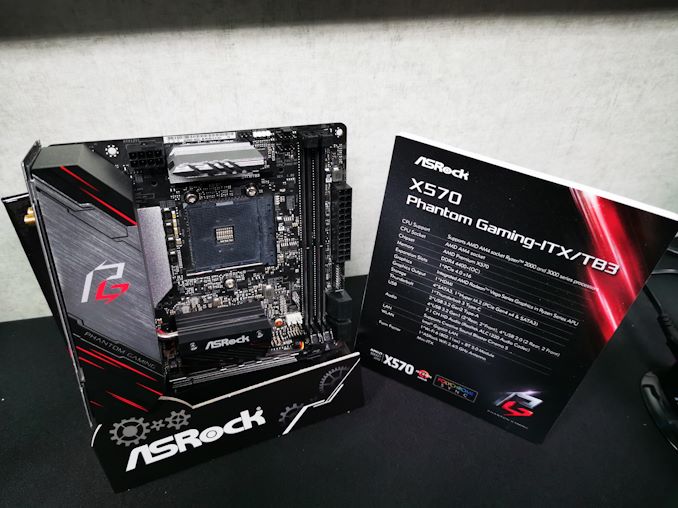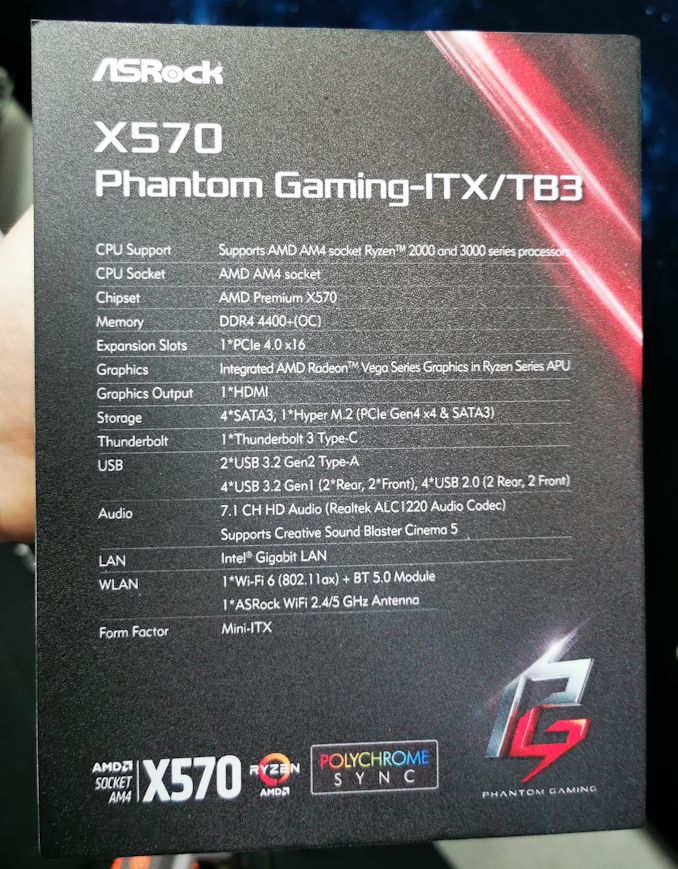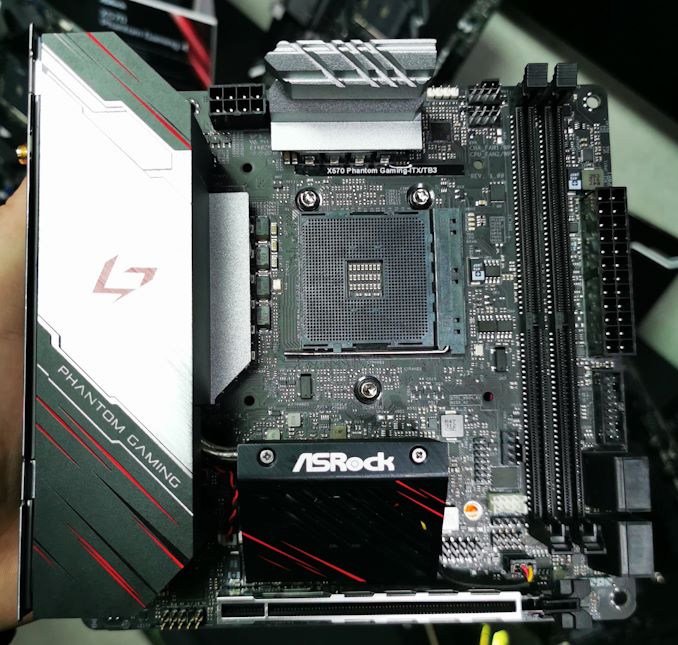ASRock X570 Phantom Gaming-ITX TB3: The Small Motherboard with a Side of Everything
by Gavin Bonshor on June 18, 2019 4:00 PM EST
During Computex 2019, ASRock announced its upcoming X570 range ready for the launch of AMD's Ryzen 3000 series processors. One of the motherboard highlights of the show was the ASRock X570 Phantom Gaming-ITX TB3, which includes a very solid feature set including Thunderbolt 3 Type-C, a solid looking 10-phase power delivery, and a Wi-Fi 6 802.11ax wireless interface.
The ASRock X570 Phantom Gaming-ITX TB3 joins a small handful of small form factor X570 models at launch but looks to stand-out from the crowd with a major feature; a Thunderbolt 3 Type-C connector on the rear panel. Following in line with the rest of its premium X570 product stack, ASRock has equipped the board with a hefty looking 10-phase power delivery, and official support for DDR4-4400 memory across two available slots. A single full-length PCIe 4.0 x16 slot is located at the bottom of the board, with a single PCIe 4.0 x4 M.2 slot, and just four SATA ports. The networking is handled by an Intel Gigabit port, while the Wi-Fi 6 802.11ax wireless interface is controlled by the Killer AX1650 interface with support for BT 5 devices.
On the rear panel alongside the single Thunderbolt 3 Type-C connector which is the highlight of the board, the ASRock X570 Phantom Gaming-ITX TB3 also includes a single USB 3.1 G2 Type-A, a single USB 3.1 G2 Type-C, and two USB 3.1 G1 Type-A ports. On the display model at Computex, there is a clear CMOS button, a DisplayPort input and HDMI video output, with a PS/2 combo port, and five 3.5 mm color coded audio jacks with a S/PDIF optical output due to the use of a Realtek ALC1220 HD audio codec.

The specifications listed at Computex differ from what's actually featured physically on the rear panel. ASRock told us there were last minute changes.
The availability and pricing of the ASRock X570 Phantom Gaming-ITX TB3 mini-ITX motherboard are currently unknown, but we expect it to launch with the rest of ASRock's announced X570 models on 7/7.
| Want to keep up to date with all of our Computex 2019 Coverage? | ||||||
 Laptops |
 Hardware |
 Chips |
||||
| Follow AnandTech's breaking news here! | ||||||












37 Comments
View All Comments
jrs77 - Tuesday, June 18, 2019 - link
Still wondering when we get to see the B550-boards, as these X570-chips are total overkill for most users and hotheaded aswell and not suitable for a mITX-systrem imho.Death666Angel - Tuesday, June 18, 2019 - link
There are Intel HEDT miniITX systems (with a much larger socket area for example), so I think these will be fine. Although I wouldn't mind B550 to arrive soon, but I heard it will be in 2020.darkswordsman17 - Tuesday, June 18, 2019 - link
Seemed like people discussing in the forums indicate that AMD has likely been waiting on ASMedia to get their PCIe 4 chipset worked out, and that it'll be probably next year. Maybe launch alongside Zen 2 APUs.darkswordsman17 - Tuesday, June 18, 2019 - link
Displayport in? I'd think HDMI in would be a lot more popular (but maybe its more difficult to manage due to DRM/HDCP related stuff?). Personally, I wish all of those ports would be input/output capable (and that laptops and tablets would be able to do video in). Heck, I think there would be a market for All-in-Wonder style cards that featured digital tuner and HDMI capture capability.The rest sounds decent. I'd like some more USB ports myself (for me best setup would be 2 TB3, 2 USB-C latest gen, and then 4 USB-A latest gen ports).
DanNeely - Tuesday, June 18, 2019 - link
DP in instead of HDMI is because thunderbolt has native passthrough support for the former; which simplifies routing the video from your DGPU to a display on the end of the thunderbolt port.KateH - Tuesday, June 18, 2019 - link
The video-in port is DP because it's not for video capture- It's there to allow a PCIe GPU to pass video to the Thunderbolt controller to allow for TB3 displays to be connected. Some TB3-equipped Intel boards have passthrough ports too, AFAIK there's no way to use them for capture. It just sends the signal to the Thunderbolt port. It has to be DP because that's the signaling that TB uses for its video modes.rpg1966 - Wednesday, June 19, 2019 - link
Dumb question - why can't the passthrough from GPU->TB3 happen on the motherboard itself?KateH - Wednesday, June 19, 2019 - link
this way is (despite the requirement for external passthru cables) less convoluted.Thunderbolt uses DisplayPort signals for its video mode. GPUs do not pass DP signals directly thru the PCIe slot**. Doing without the cable would require something like a setup where the GPU passes video frames across the PCIe bus to the CPU which would send a video stream back over the PCIe bus to a dedicated DP encoder chip that would then send a DP stream to the Thunderbolt 3 controller via a line in the motherboard.
AFAIK there's no standards for doing that which makes the required interactions between hardware/firmware/software rather daunting, probably requiring custom GPU drivers for best performance, or a software solution (akin to how GPU-accelerated remote desktop works) that would reduce performance and add latency and more failure points/compatibility issues. Easier to just use the DP encoder on the GPU and an external cable.
** laptops with dGPU and Thunderbolt don't need the passthru cable because the dGPU is already passing DP (technically eDP) signal either thru dedicated pins on the MXM slot or directly onto the motherboard for soldered GPUs.
rpg1966 - Wednesday, June 19, 2019 - link
Thanks for the detailed reply!But since a DP encoder on the GPU already, would it not be possible to send signals from the GPU's DP encoder back over the PCIe bus to the CPU/TB3 gear, avoiding the need for the second DP encoder you refer to?
Death666Angel - Wednesday, June 19, 2019 - link
That's probably a question of money. If you go the PCIe route, every graphics card would need the ability to output the video stream via PCIe and I don't think that is mainstream or even a standard right now, meaning very limited graphics card support. It sure as hell would make things on every card more complicated and costly for the one or two TB boards out there that will have a small market share. Also, I don't think you understand his DP encoder setup. Doing it over the PCIe bus would mean getting another DP encoder somewhere. Doing it via DP port can use the already existing DP encoder. This is the path of least resistance.